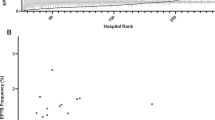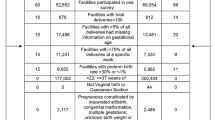Abstract
Objective:
Given the increasing rates of labor induction and cesarean delivery, and efforts to reduce early term births, we examined recent trends in methods and timing of delivery.
Study Design:
We identified delivery methods and medical indications for delivery from administrative hospital discharge data for 231 691 deliveries in 2006 and 213 710 deliveries in 2010 from 47 specialty care member hospitals of the National Perinatal Information Center/Quality Analytic Services. In a subset of 17 hospitals, we examined trends by gestational age.
Result:
From 2006 to 2010, there was an 11% increase in labor induction and a 6% increase in cesarean delivery, largely due to repeat cesareans. There was a 4 per 100 reduction in early term births (37 to 38 weeks), mostly due to a decline in non-medically indicated interventional deliveries.
Conclusion:
We report a shift in deliveries at 38 weeks, which we believe may be attributed to efforts to actively limit non-medically indicated early term deliveries.
This is a preview of subscription content, access via your institution
Access options
Subscribe to this journal
Receive 12 print issues and online access
$259.00 per year
only $21.58 per issue
Buy this article
- Purchase on SpringerLink
- Instant access to full article PDF
Prices may be subject to local taxes which are calculated during checkout


Similar content being viewed by others
References
MacDorman MF, Declercq E, Zhang J . Obstetrical intervention and the singleton preterm birth rate in the United States from 1991–2006. Am J Public Health 2010; 100 (11): 2241–2247.
Menacker F, Hamilton BE . Recent trends in cesarean delivery in the United States. NCHS Data Brief 2010; 35: 1–8.
Denk CE, Kruse LK, Jain NJ . Surveillance of cesarean section deliveries, New Jersey, 1999–2004. Birth 2006; 33 (3): 203–209.
MacDorman MF, Menacker F, Declercq E . Cesarean birth in the United States: epidemiology, trends, and outcomes. Clin Perinatol 2008; 35 (2): 293–307.
Martin JA, Kung HC, Mathews TJ, Hoyert DL, Strobino DM, Guyer B et al. Annual summary of vital statistics: 2006. Pediatrics 2008; 121 (4): 788–801.
Ananth CV, Vintzileos AM . Trends in cesarean delivery at preterm gestation and association with perinatal mortality. Am J Obstet Gynecol 2011; 204 (6): 505.
Bettegowda VR, Dias T, Davidoff MJ, Damus K, Callaghan WM, Petrini JR . The relationship between cesarean delivery and gestational age among US singleton births. Clin Perinatol 2008; 35 (2): 309–323.
MacDorman MF, Mathews TJ, Martin JA, Malloy MH . Trends and characteristics of induced labour in the United States, 1989–98. Paediatr Perinat Epidemiol 2002; 16 (3): 263–273.
Wier LM, Pfunter A, Maeda J, Stranges E, Ryan K, Jagadish P et al. HCUP Facts and Figures: statistics on hospital-based care in the United States, 2009. Agency Healthcare Res and Qual: Rockville, MD, 2011; 1–101 Available http://www.hcup-us.ahrq.gov/reports.jsp.
Martin JA, Osterman MJ, Sutton PD . Are preterm births on the decline in the United States? Recent data from the National Vital Statistics System. NCHS Data Brief 2010; 39: 1–8.
MacDorman M, Declercq E, Menacker F . Recent trends and patterns in cesarean and vaginal birth after cesarean (VBAC) deliveries in the United States. Clin Perinatol 2011; 38 (2): 179–192.
Ehrenthal DB, Jiang X, Strobino DM . Labor induction and the risk of a cesarean delivery among nulliparous women at term. Obstet Gynecol 2010; 116 (1): 35–42.
Murthy K, Grobman WA, Lee TA, Holl JL . Trends in induction of labor at early-term gestation. Am J Obstet Gynecol 2011; 204 (5): 435.
Lisonkova S, Hutcheon JA, Joseph KS . Temporal trends in neonatal outcomes following iatrogenic preterm delivery. BMC Pregnancy Childbirth 2011; 11: 39.
Joseph KS, Demissie K, Kramer MS . Obstetric intervention, stillbirth, and preterm birth. Semin Perinatol 2002; 26 (4): 250–259.
Davidoff MJ, Dias T, Damus K, Russell R, Bettegowda VR, Dolan S et al. Changes in the gestational age distribution among U.S. singleton births: impact on rates of late preterm birth, 1992 to 2002. Semin Perinatol 2006; 30 (1): 8–15.
Tita AT, Landon MB, Spong CY, Lai Y, Leveno KJ, Varner MW et al. Timing of elective repeat cesarean delivery at term and neonatal outcomes. N Engl J Med 2009; 360 (2): 111–120.
Oshiro BT, Henry E, Wilson J, Branch DW, Varner MW, Women MW et al. Decreasing elective deliveries before 39 weeks of gestation in an integrated health care system. Obstet Gynecol 2009; 113 (4): 804–811.
Fisch JM, English D, Pedaline S, Brooks K, Simhan HN . Labor induction process improvement: a patient quality-of-care initiative. Obstet Gynecol 2009; 113 (4): 797–803.
Clark SL, Frye DR, Meyers JA, Belfort MA, Dildy GA, Kofford S et al. Reduction in elective delivery at <39 weeks of gestation: comparative effectiveness of 3 approaches to change and the impact on neonatal intensive care admission and stillbirth. Am J Obstet Gynecol 2010; 203 (5): 449.
Ehrenthal DB, Hoffman MK, Jiang X, Ostrum G . Neonatal outcomes after implementation of guidelines limiting elective delivery before 39 weeks of gestation. Obstet Gynecol 2011; 118 (5): 1047–1055.
American Hospital Association. AHA Annual Survey Database Fiscal Year 2010 Documentation Manual. Health Forum, LLC, 2011.
The Joint Commission. Specifications Manual for Joint Commission National Quality Core Measures—Version 2011A, 2010 Available http://manual.jointcommission.org/releases/archive/TJC2011A/.
Yudkin PL, Wood L, Redman CW . Risk of unexplained stillbirth at different gestational ages. Lancet 1987; 1 (8543): 1192–1194.
Joseph KS . Theory of obstetrics: an epidemiologic framework for justifying medically indicated early delivery. BMC Pregnancy Childbirth 2007; 7: 4.
Satagopan JM, Ben-Porat L, Berwick M, Robson M, Kutler D, Auerbach AD . A note on competing risks in survival data analysis. Br J Cancer 2004; 91 (7): 1229–1235.
Simpson KR . An overview of distribution of births in United States hospitals in 2008 with implications for small volume perinatal units in rural hospitals. J Obstet Gynecol Neonatal Nurs 2011; 40 (4): 432–439.
Hamilton BE, Martin JA, Ventura SJ . Births: preliminary data for 2008. Natl Vital Stat Rep 2010; 58 (16): 1–17.
Martin JA, Hamilton BE, Ventura SJ, Osterman M, Wilson EC, Mathews TJ . Births: Final data for 2010. Natl Vital Stat Rep 2012; 61 (1)).
Yeast JD, Jones A, Poskin M . Induction of labor and the relationship to cesarean delivery: a review of 7001 consecutive inductions. Am J Obstet Gynecol 1999; 180 (3 Pt 1): 628–633.
Seyb ST, Berka RJ, Socol ML, Dooley SL . Risk of cesarean delivery with elective induction of labor at term in nulliparous women. Obstet Gynecol 1999; 94 (4): 600–607.
Schneider S, Freerksen N, Rohrig S, Hoeft B, Maul H . Gestational diabetes and preeclampsia—similar risk factor profiles? Early Hum Dev 2012; 88 (3): 179–184.
MacDorman MF, Munson ML, Kirmeyer S . Fetal and perinatal mortality, United States, 2004. Natl Vital Stat Rep 2007; 56 (3): 1–19.
Author information
Authors and Affiliations
Corresponding author
Ethics declarations
Competing interests
The authors declare no conflict of interest.
Rights and permissions
About this article
Cite this article
Danilack, V., Botti, J., Roach, J. et al. Changes in delivery methods at specialty care hospitals in the United States between 2006 and 2010. J Perinatol 33, 919–923 (2013). https://doi.org/10.1038/jp.2013.90
Received:
Revised:
Accepted:
Published:
Issue Date:
DOI: https://doi.org/10.1038/jp.2013.90



